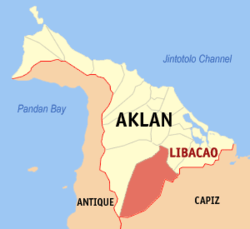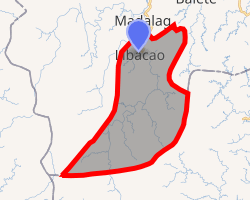Libacao
Libacao, officially the Municipality of Libacao (Aklanon: Banwa it Libacao; Hiligaynon: Banwa sang Libacao; Tagalog: Bayan ng Libacao), is a 3rd class municipality in the province of Aklan, Philippines. According to the 2015 census, it has a population of 28,241 people.[3]
Libacao | |
|---|---|
| Municipality of Libacao | |
 Seal | |
 Map of Aklan with Libacao highlighted | |
OpenStreetMap 
| |
.svg.png) Libacao Location within the Philippines | |
| Coordinates: 11°29′N 122°18′E | |
| Country | |
| Region | Western Visayas (Region VI) |
| Province | Aklan |
| District | 1st district of Aklan |
| Barangays | 23 (see Barangays) |
| Government | |
| • Type | Sangguniang Bayan |
| • Mayor | Charito I. Navarosa |
| • Vice Mayor | Vincent I. Navarosa |
| • Congressman | Carlito S. Marquez |
| • Electorate | 18,919 voters (2019) |
| Area | |
| • Total | 254.98 km2 (98.45 sq mi) |
| Population (2015 census)[3] | |
| • Total | 28,241 |
| • Density | 110/km2 (290/sq mi) |
| • Households | 6,556 |
| Economy | |
| • Income class | 3rd municipal income class |
| • Poverty incidence | 30.13% (2015)[4] |
| • Revenue (₱) | 96,357,780.75 (2016) |
| Time zone | UTC+8 (PST) |
| ZIP code | 5602 |
| PSGC | |
| IDD : area code | +63 (0)36 |
| Climate type | tropical climate |
| Native languages | Aklan Hiligaynon Capiznon Tagalog |
In 1948, the arrabal of Madalag was separated from Libacao and constituted as a separate town, with the following barrios: Logohon, Singay, Balactasan, Cabangahan, Cabilawan, Pangitan, San Jose, Talimagao, Talangban, Alaminos, Catabana, Bakyang, Calicia, Mercedes, Maria Cristina, Dit-ana, Guinato-an, Tigbauan, Alas-as, Mamba, Medina, Panikyason, and Paningayan.[5]
Geography
Libacao is located at 11°29′N 122°18′E. It is 31 kilometres (19 mi) from the provincial capital Kalibo.
According to the Philippine Statistics Authority, the municipality has a land area of 254.98 square kilometres (98.45 sq mi) [2] constituting 14.00% of the 1,821.42-square-kilometre- (703.25 sq mi) total area of Aklan.
Climate
| Climate data for Libacao, Aklan | |||||||||||||
|---|---|---|---|---|---|---|---|---|---|---|---|---|---|
| Month | Jan | Feb | Mar | Apr | May | Jun | Jul | Aug | Sep | Oct | Nov | Dec | Year |
| Average high °C (°F) | 28 (82) |
29 (84) |
31 (88) |
32 (90) |
31 (88) |
30 (86) |
30 (86) |
29 (84) |
29 (84) |
29 (84) |
29 (84) |
28 (82) |
30 (85) |
| Average low °C (°F) | 22 (72) |
22 (72) |
22 (72) |
23 (73) |
25 (77) |
25 (77) |
25 (77) |
25 (77) |
25 (77) |
24 (75) |
23 (73) |
23 (73) |
24 (75) |
| Average precipitation mm (inches) | 64 (2.5) |
44 (1.7) |
58 (2.3) |
83 (3.3) |
204 (8.0) |
304 (12.0) |
334 (13.1) |
291 (11.5) |
310 (12.2) |
281 (11.1) |
172 (6.8) |
97 (3.8) |
2,242 (88.3) |
| Average rainy days | 12.5 | 8.9 | 11.3 | 14.1 | 24.2 | 28.0 | 29.6 | 28.2 | 28.1 | 28.1 | 20.2 | 15.2 | 248.4 |
| Source: Meteoblue [6] | |||||||||||||
Barangays
Libacao is politically subdivided into 23 barangays.[7]
| PSGC | Barangay | Population | ±% p.a. | |||
|---|---|---|---|---|---|---|
| 2015[3] | 2010[8] | |||||
| 060409001 | Agmailig | 2.6% | 736 | 755 | −0.48% | |
| 060409002 | Alfonso XII | 4.7% | 1,331 | 1,323 | 0.11% | |
| 060409003 | Batobato | 1.8% | 501 | 453 | 1.94% | |
| 060409004 | Bonza | 1.4% | 395 | 333 | 3.30% | |
| 060409005 | Calacabian | 3.1% | 865 | 932 | −1.41% | |
| 060409006 | Calamcan | 2.2% | 620 | 613 | 0.22% | |
| 060409007 | Can-Awan | 1.7% | 487 | 542 | −2.02% | |
| 060409008 | Casit-an | 1.2% | 352 | 342 | 0.55% | |
| 060409010 | Guadalupe | 5.4% | 1,529 | 1,412 | 1.53% | |
| 060409011 | Janlud | 3.6% | 1,011 | 740 | 6.12% | |
| 060409012 | Julita | 7.0% | 1,971 | 1,763 | 2.15% | |
| 060409013 | Luctoga | 5.1% | 1,442 | 1,451 | −0.12% | |
| 060409014 | Magugba | 2.1% | 600 | 644 | −1.34% | |
| 060409015 | Manika | 7.4% | 2,091 | 2,622 | −4.22% | |
| 060409016 | Ogsip | 3.3% | 920 | 1,066 | −2.77% | |
| 060409017 | Ortega | 4.4% | 1,248 | 1,309 | −0.90% | |
| 060409018 | Oyang | 3.8% | 1,068 | 1,028 | 0.73% | |
| 060409019 | Pampango | 5.2% | 1,455 | 1,360 | 1.29% | |
| 060409020 | Pinonoy | 2.6% | 727 | 708 | 0.51% | |
| 060409021 | Poblacion | 14.2% | 4,010 | 3,661 | 1.75% | |
| 060409022 | Rivera | 2.3% | 648 | 596 | 1.61% | |
| 060409023 | Rosal | 5.6% | 1,591 | 1,476 | 1.44% | |
| 060409024 | Sibalew | 2.6% | 735 | 703 | 0.85% | |
| Total | 28,241 | 28,005 | 0.16% | |||
Demographics
| Year | Pop. | ±% p.a. |
|---|---|---|
| 1903 | 4,876 | — |
| 1918 | 17,125 | +8.74% |
| 1939 | 20,253 | +0.80% |
| 1948 | 13,523 | −4.39% |
| 1960 | 14,913 | +0.82% |
| 1970 | 15,837 | +0.60% |
| 1975 | 20,243 | +5.05% |
| 1980 | 21,683 | +1.38% |
| 1990 | 21,429 | −0.12% |
| 1995 | 22,812 | +1.18% |
| 2000 | 25,983 | +2.83% |
| 2007 | 26,610 | +0.33% |
| 2010 | 28,005 | +1.88% |
| 2015 | 28,241 | +0.16% |
| Source: Philippine Statistics Authority[3][8][9][10] | ||
In the 2015 census, Libacao had a population of 28,241.[3] The population density was 110 inhabitants per square kilometre (280/sq mi).
Attractions
- Nasuraan Falls and Kaeabnakan Falls — located in the remote barangay of Oyang.
- Taroytoy — eyed to be the Summer Capital of Central Philippines.
- Philippine Spotted Deer — a nocturnal and endangered species of deer located primarily in the rainforests of the Visayan islands of Panay and Negros though it once roamed other islands such as Cebu, Guimaras, Leyte, Masbate, and Samar.
- Libacao Wild River — longest Wild River in the Philippines.
Products
- Coconut - Libacao has a lot of mountains and plains which are suitable for coconuts.
- Abaca - Abaca fiber is also another product that Libacaonons produce.
References
- "Municipality". Quezon City, Philippines: Department of the Interior and Local Government. Retrieved 31 May 2013.
- "Province: Aklan". PSGC Interactive. Quezon City, Philippines: Philippine Statistics Authority. Retrieved 12 November 2016.
- Census of Population (2015). "Region VI (Western Visayas)". Total Population by Province, City, Municipality and Barangay. PSA. Retrieved 20 June 2016.
- "PSA releases the 2015 Municipal and City Level Poverty Estimates". Quezon City, Philippines. Retrieved 12 October 2019.
- "Republic Act No. 297; An Act Creating the Municipality of Madalag in the Province of Capiz". The Corpus Juris. 17 June 1948. Archived from the original on 21 October 2016. Retrieved 21 October 2016.
- "Libacao: Average Temperatures and Rainfall". Meteoblue. Retrieved 1 May 2020.
- "Municipal: Libacao". PSGC Interactive. Quezon City, Philippines: Philippine Statistics Authority. Retrieved 8 January 2016.
- Census of Population and Housing (2010). "Region VI (Western Visayas)". Total Population by Province, City, Municipality and Barangay. NSO. Retrieved 29 June 2016.
- Censuses of Population (1903–2007). "Region VI (Western Visayas)". Table 1. Population Enumerated in Various Censuses by Province/Highly Urbanized City: 1903 to 2007. NSO.
- "Province of Aklan". Municipality Population Data. Local Water Utilities Administration Research Division. Retrieved 17 December 2016.